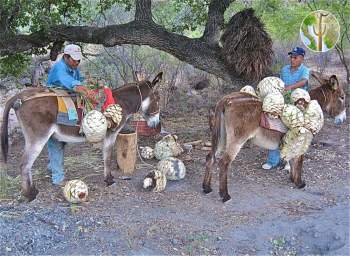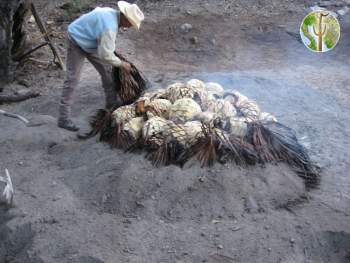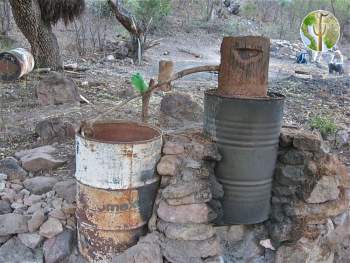"La Ruta Bacanora"
Off the Wagon and On the Whiskey Trail in the Sonoran Hinterlands
by Michael Huckaby
COWBOY COUNTRY
 Sahuaripa sits nestled against the foothills of the western flank of the Sierra Madre Occidental. It is at the north end of the valley of Tacupeto on the north flowing Rio Sahuaripa just before it enters the Rio Yaqui. This is cattle country. Some agriculture exist where farmers have taken advantage of the rivers leaving the sierras, but mostly it's cattle country. It's a tradition that goes back some 400 years, to when the Opata Indians were displaced by Spanish missionaries and miners. Cattle were introduced to feed the workers.
Sahuaripa sits nestled against the foothills of the western flank of the Sierra Madre Occidental. It is at the north end of the valley of Tacupeto on the north flowing Rio Sahuaripa just before it enters the Rio Yaqui. This is cattle country. Some agriculture exist where farmers have taken advantage of the rivers leaving the sierras, but mostly it's cattle country. It's a tradition that goes back some 400 years, to when the Opata Indians were displaced by Spanish missionaries and miners. Cattle were introduced to feed the workers.
Vaqueros ride these hills in full length thick leather chaps to protect themselves in the thorn forest. Plants like vinorama, catclaw, and canyon hackberry vie for the opportunity to draw blood. The cattle get into some pretty difficult situations. To keep them safe is tough work with little pay, but it's a family tradition.
In the fall, there's a revival of another longstanding tradition. It starts when the first cool breezes signal the end of summer. The vaqueros sharpen their machetes and hatchets and harvest the fruits of the agave plants for the local moonshine called Bacanora. The production was legalized in 1992, but it's still made by small groups in remote locations using age-old, tried and true equipment. In fact the most modern contraptions at the vinata are the 55 gallon barrel and copper tubing.
FAMILY TRADITION
 It all starts with the agave. In Jalisco, the agave tequilliana weber is used for tequila, while in Oaxaca the agave espadin is used for mescal. In Chihuahua, the agave sotol and the agave lechuguilla are used to make their regional drinks, but in Sonora they use the wild agave yaqui. These plants have razor sharp petals up to four feet long, and a flowering stalk (quijote) that can reach 30 feet. They don't just harvest the agaves that have bloomed. Although these are the sweetest plants, the vaqueros want a little bitterness in the mix, too. This yin and yang was reiterated a number of times during our recent visit to the Rancho Calabozo. Our host Diego Ezzre introduced us to Kiko, the ranch's head vaquero. He was relaxing after riding the range that day. A jaguar had taken down a calf 3 days earlier. The calf had managed to return to the corral, but was fatally wounded. Kiko had checked for tracks, and determined the cat had left the ranch. For a while, it was somebody else's problem. We asked about the liquor making, and Kiko said we could help with the harvest in the morning.
It all starts with the agave. In Jalisco, the agave tequilliana weber is used for tequila, while in Oaxaca the agave espadin is used for mescal. In Chihuahua, the agave sotol and the agave lechuguilla are used to make their regional drinks, but in Sonora they use the wild agave yaqui. These plants have razor sharp petals up to four feet long, and a flowering stalk (quijote) that can reach 30 feet. They don't just harvest the agaves that have bloomed. Although these are the sweetest plants, the vaqueros want a little bitterness in the mix, too. This yin and yang was reiterated a number of times during our recent visit to the Rancho Calabozo. Our host Diego Ezzre introduced us to Kiko, the ranch's head vaquero. He was relaxing after riding the range that day. A jaguar had taken down a calf 3 days earlier. The calf had managed to return to the corral, but was fatally wounded. Kiko had checked for tracks, and determined the cat had left the ranch. For a while, it was somebody else's problem. We asked about the liquor making, and Kiko said we could help with the harvest in the morning.
The agaves have a weak root system and are easy to uproot. They are rolled upside down, and the petals are sheared off by the jimador to produce a heart called a pina or cabeza. A typical batch may require 50 to 60 heads. The vaqueros traversed the steep rocky hillside, expertly slicing the leaves off the plant. All the leaves but one; they needed a handle didn't they? Kiko was ably assisted by his son Ramon, and questionably aided by the 5 of us onlookers. I'll give him credit for patience, but we knew our place when he gave us the opportunity to wield the hatchet. Mostly we were too timid and left too much leaf. The sweetness and flavor is in the heart. They rolled the pinas downhill toward the trail and worked their way along the slope all day long.
 In the afternoon, an old vaquero showed up with two burros. This slim wisp of a man with the leathery skin was Kiko's father Cruz. He was the main vaquero when Diego's father ran the ranch! He methodically gathered up the heavy pinas and tied them to the fuste in pairs by the leash that Kiko had left on each one. His movements were the epitome of efficiency. These little sierra burros can carry about a hundred pounds, and Cruz knew there were several trips to make and loaded them accordingly. He dropped them off to the side at the vinata. Kiko and Ramon were already there preparing the roasting pit, called a maya. The vinata also contains a fermentation tank called the barranco, a place to smash the baked pinas (cuba), and the tren- the distilling apparatus consisting of two 55 gallon barrels. It's all amazingly simple and effective.
In the afternoon, an old vaquero showed up with two burros. This slim wisp of a man with the leathery skin was Kiko's father Cruz. He was the main vaquero when Diego's father ran the ranch! He methodically gathered up the heavy pinas and tied them to the fuste in pairs by the leash that Kiko had left on each one. His movements were the epitome of efficiency. These little sierra burros can carry about a hundred pounds, and Cruz knew there were several trips to make and loaded them accordingly. He dropped them off to the side at the vinata. Kiko and Ramon were already there preparing the roasting pit, called a maya. The vinata also contains a fermentation tank called the barranco, a place to smash the baked pinas (cuba), and the tren- the distilling apparatus consisting of two 55 gallon barrels. It's all amazingly simple and effective.
PRIDE IN PRODUCT
The stone lined maya is about 8 feet across by almost 4 feet deep. Seasoned oak is laid in the bottom 2 to 3 feet thick. This takes about half a cord of wood. Flat rocks are carefully stacked on top of the wood before lots of rocks are piled on. The wood is lit with a coal from another fire at a small hole in the center of the pile. Once the fire is going, the rocks reduce the oxygen content to make charcoal. The fire must be watched constantly, and rocks added as the pile of rocks collapses. After a few hours, it's time to add the hearts. A layer of sliced pithaya is added first for the moisture to prevent burning. Wet palm fronds are layered on, and then completely covered in dirt. Careful attention is given to the pyramid of dirt to make sure no wisps of smoke escape. The whole thing could burn up if oxygen is allowed to get in! The hearts are baked for two to three days. This process is called tatemada- to roast or bake in coals.
The tatema is then pulverized with the blunt end of an axe. The fibrous mass is then known as ziete. Another fire is built to heat up the shallow fermenting well called the barranco. The macerated hearts are but in a heavy plastic bag in the warm well. They'll stay there until fermentation is well underway, maybe 5 to 6 days. A little warm water may have to be added to aid fermentation. The zeite can be removed when there is no more sweetness left in the liquid. This lack of sweetness also has a distinct aroma. Ramon explains that it has to be smelled and tasted, it's the result of experience. Ramon, the third generation as Cruz grandson, wears a ballcap and an earring, but he's here to learn the process.
Then it's time to prepare the tren. A fire is started under one barrel with about 20 cm of water in it. The warm wet zeite is added by pitchfork. This mash is boiled for about 3 hours to extract the alcohol. The vapor rises in the first barrel and exits via a copper tube to the second barrel. The second barrel is filled with water or cold wet mud to cause condensation. A thin stream of bacanora exits the copper tube (culebra). This first run is called the cabeza. It is very strong. Too strong, it burns the throat and weakens with age: "hace agua", say the vaqueros. The second run is called the vino or resaca. It is smooth, and the flavor can be enjoyed. A third run called the cola is weak, flojo say the vaqueros. A mix of the 3 runs produces a balance that meets the approval of the 3 generations of vaqueros. "Pruebela, salud".
According to the monthly publication SonoraEs... (#55, Oct 2008, p14), production of Bacanora is an important component of the rural economy. There are 3000 producers in 35 townships. It employs 9000 people who produce 250,000 liters of the vino, as it is known locally.
